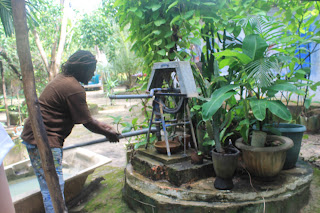This is Malayan, our day watchman and friend. One rainy Saturday he taught us all how to brew attaya which is very popular in The Gambia. We had drank attaya before during orientation, but did not know how to make it. Simply put attaya is tea, even though the process of making the attaya is more important than the tea itself I'm still going to try and explain it. We have a gas stove here (side note: we don't have an oven so we can't bake goodies :( ) and that is what Malayan is posing with here. There is a tea pot on the stove and he's holding an attaya glass. this is the general set up. People usually brew attaya outside, but since it was raining our lesson was indoors. People will brew attaya along the side of the road or outside their house and anyone who walks by is welcome to join the attaya party.
Brewing attaya is an intense process. You put lots of Chinese Green Tea and a lot of sugar in the tea pot along with water then brew it. This is what it looks like while it's brewing which is pretty gross atually haha but it ends up looking better I promise! As you can see it's not tea bags like most people are used to in the states, but actual tea leaves called warrga here. Gambians add LOTS of sugar. Attaya glasses full. They are known to add a lot of sugar to anything and look at us Americans funny when we only ask for a scoop of sugar in our coffee or no sugar at all.
The more bubbles in the tea the better so you have to pour it from one glass to another (like Malayn is doing here) in order to get the bubbles. Then you pour it back in the pot and brew it some more and then you repeat the process. Like I said it's more about the social aspect so while this long process is going on people (mostly men) sit around the pot and discuss sports or anything in general.
This is the finishing product! You are supposed to add more water to the pot after the first "batch" of attaya is made to make another "batch" and you're to do this three times. So the first round is stronger and then it gets weaker each time. Depending on how fast people move brewing attaya could take hours. If you want to know more about it click here!


















































